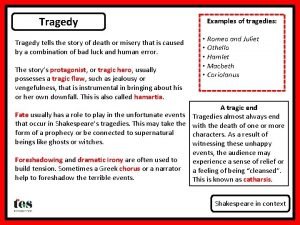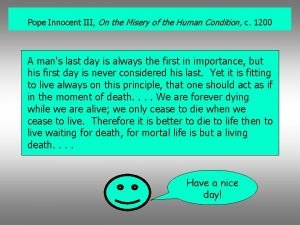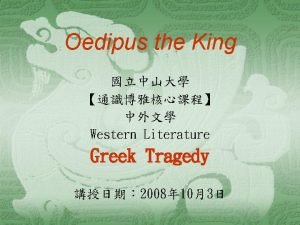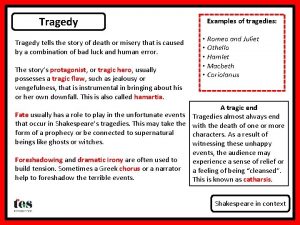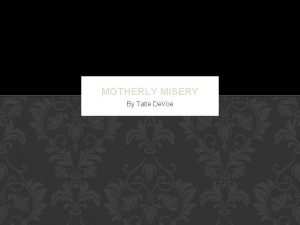Tragedy tells the story of death or misery





- Slides: 5

Tragedy tells the story of death or misery that is caused by a combination of bad luck and human error. The story’s protagonist, or tragic hero, usually possesses a tragic flaw, such as jealousy or vengefulness, that is instrumental in bringing about his or her own downfall. This is also called hamartia. Examples of tragedies: • Romeo and Juliet • Othello • Hamlet • Macbeth • Coriolanus A tragic end Fate usually has a role to play in the unfortunate events Tragedies almost always end that occur in Shakespeare’s tragedies. This may take the with the death of one or more form of a prophecy or be connected to supernatural characters. As a result of beings like ghosts or witches. witnessing these unhappy events, the audience may Foreshadowing and dramatic irony are often used to experience a sense of relief or build tension. Sometimes a Greek chorus or a narrator a feeling of being “cleansed”. help to foreshadow the terrible events. This is known as catharsis. Shakespeare in context

Comedy pits two people or groups of people against each other, often with humorous consequences. Although they are not always entirely funny, Shakespeare’s comedies often use a number of tricks to make audiences laugh. These include slapstick, innuendo, disguises and mistaken identity. The fool is a key comedic character. The fool acts as a sort of jester, who will make jokes, sing songs and comment on the action in a funny way. Strong female characters often appear in Shakespeare’s comedies. They are smart, witty and feisty. They may dress up as men to help themselves succeed in a world where their own power is limited. Examples of comedies: • A Midsummer Night’s Dream • Twelfth Night • Much Ado About Nothing • As You Like It • The Taming of the Shrew Happily ever after Love is usually an important theme in Shakespeare’s comedies. Humour stems from a couple overcoming obstacles to be together. Comedies often end with marriage, a return to order and a sense of hope. Shakespeare in context

Tragicomedy This type of drama combines elements of tragedy and comedy. The plot may seem to be moving towards a tragic ending, but a last-minute plot twist will usually give a happy resolution. Many of Shakespeare’s tragicomedies are referred to as romances. These plays mix serious human problems, such as exile and separation, with elements of myth and fantasy, like magic or strange creatures. Humour may lighten the mood within a subplot or a masque – a popular form of courtly entertainment that combined music, dance and mime with dialogue. The tragicomedies often end with reconciliation, resurrection and forgiveness. Examples of tragicomedies: • The Winter’s Tale • The Tempest • Cymbeline • Pericles Importance of family Instead of focusing on love and lovers, tragicomedies often place family conflict at the centre of the action. In particular, we see family members separated and then reunited. Shakespeare in context

History plays These plays are inspired by real events from British history. Shakespeare used the facts as a basis to explore issues of power and morality and to comment on contemporary issues or events that were taking place in his lifetime, but did not always retell stories truthfully. By law, all theatre companies had to be supported by a financial backer, or patron. It was common for groups to produce plays that were designed to please the patron. This was particularly true for history plays. Shakespeare’s company was supported by the Lord Chamberlain and later by King James I, under whose patronage the company became known as The King’s Men. For these reasons, we cannot take Shakespeare’s plays as accurate representations of history. Examples of history plays: • Henry VI (parts 1, 2 and 3) • Richard III • Richard II • Henry IV (parts 1 and 2) • Henry V Houses at war Most of the history plays focus on the years during and leading up to the Wars of the Roses, which were fought between the houses of Lancaster and York between 1422 and 1485. Shakespeare in context

Problem plays The problem plays are a group of Shakespeare’s comedies which are seen to be “problematic” in some way. The plots are a confusing mixture of fantasy and reality and cannot be clearly defined as comedy or tragedy. Characters are often difficult to understand or categorize. As a result, audiences may struggle to make sense of what they see. These plays take social or moral problems as their subject matter. The issue will be explored through the course of the play, yet a clear answer will rarely have been reached by the time the plot is resolved. While the play’s ending may appear to be happy, the problem will remain to cast a shadow over things. Examples of problem plays: • All’s Well That Ends Well • Measure for Measure • Troilus and Cressida Ahead of the curve The problem plays are often said to have a “modern” feel. The cynical outlook and lack of easy resolution apparent in these plays are characteristic of the work of later dramatists, such as Henrik Ibsen, and demonstrate the continued relevance of Shakespeare today. Shakespeare in context
